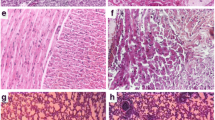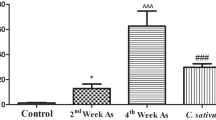Abstract
Arsenic a metalloid and environmental contaminated has been found to be associated with public health problems in the affected areas. It is naturally occurred in groundwater and its accumulation in plant and animals leads to toxicity in several tissues most notably hepatic organ. Arsenic exposures (3 mg/kg body weight/day for 30 days) in mice exhibited increased arsenic and Zn levels in hepatocytes associated with enhanced oxidative stress in hepatocytes while there were no significantly changes were observed in Cu level. An increase in the lipid peroxidation and decrease in the levels of reduced glutathione and activity of superoxide dismutase, catalase, and glutathione peroxidase were observed in arsenic treated mice as compared to controls. Arsenic exposure in mice also caused a significant change in serum biomarkers in the SGOT, SGPT and creatinine as compared to the controls. There were no significant changes in the serum levels of total protein in these mice. Co-administration of arsenic and fruit extract of amla (500 mg/kg body weight/day for 30 days) caused a significant reduction of arsenic transference associated with significantly decreases hepatic arsenic levels and balanced the antioxidant enzyme and levels of serum hepatic enzymes like SGOT and SGPT. The results of the present study clearly demonstrate the antioxidant property of amla that could be responsible for its protective efficacy in arsenic induced hepatic toxicity.







Similar content being viewed by others
References:
Brinkel J, Khan MMH, Kraemer A. A systematic review of arsenic exposure and its social and mental health effects with special reference to Bangladesh. Int J Environ Res Public Health. 2009;6:1609–19.
Yadav RS, Sankhwar ML, Shukla RK, Chandra R, Pant AB, Islam F, et al. Attenuation of arsenic neurotoxicity by curcumin in rats. Toxicol Appl Pharmacol. 2009;240:367–76.
Ahamed S, Sengutpa MK, Mukherjee A, Hossain A, Das B, Nayak BA, et al. Arsenic ground water contamination and its health effects in the state of Uttar Pradesh (UP) in upper and middle Ganga plain, India: severe danger. Sci Total Environ. 2006;370:310–22.
Kapaj S, Peterson H, Liber K, Bhattacharya P. Human health effects from chronic arsenic poisoning—a review. J Environ Sci Health A. 2006;41:2399–428.
Klaassen CD. Heavy metals and heavy-metal antagonist. In: Gilman AG, Rall TW, Nies AS, Taylor P, editors. The pharmacological basis of therapeutics. New York: McGraw-Hill; 1996. p. 1592–614.
Aposhian HV, Aposhian MM. Newer developments in arsenic toxicity. J Am Coll Toxicol. 1989;8:1297–305.
WHO, Environmental health criteria 224, arsenic and arsenic compounds. Inter-organization programme for the sound management of chemicals. Geneva 2001.
Liu J, Liu Y, Goyer RA, Achanzar W, Waalkes MP. Metallothionein-I/II null mice are more sensitive than wild-type mice to the hepatotoxic and nephrotoxic effects of chronic oral or injected inorganic arsenicals. Toxicol Sci. 2000;55:460–7.
Markovich D, James KM. Heavy metals mercury, cadmium and chromium inhibit the activity of the mammalian liver and kidney sulfate transporter sat-1. Toxicol Appl Pharmacol. 1999;154:181–7.
Dash DK, Yeligar VC, Nayak SS, Ghosh T, Rajalingam D, Sengupta P, et al. Evaluation of hepatoprotective and antioxidant activity of Ichnocarpus frutescens (Linn.) R. Br. on paracetamol-induced hepatotoxicity in rats. Trop J Pharm Res. 2007;6:755–65.
Ramirez P, Del Razo LM, Gutierrez-Ruiz MC, Gonsebatt ME. Arsenite induces DNA-protein crosslinks and cytokeratin expression in the WRL-68 human hepatic cell line. Carcinogenesis. 2000;21:701–6.
Khan KH. Roles of Emblica officinalis in medicine—a review. Bot Res Int. 2009;2(4):218–28.
Flora SJS. Arsenic-induced oxidative stress and its reversibility. Free Radical Biol Med. 2011;51:257–81.
Yadav RS, Sankhwar ML, Shukla RK, Chandravanshi LP, Ansari RW, Shukla PK, et al. Neuroprotective efficacy of curcumin in arsenic induced cholinergic dysfunctions in rats. NeuroToxicology. 2011;32:760–8.
Sharma A, Sharma MK, Kumar M. Modulatory role of emblica officinalis fruit extract against arsenic induced oxidative stress in swiss albino mice. Chemico-Biol interact. 2009;180:20–30.
Sharma P, Pramod J, Sharma PK, Chaturvedi SK, Kothari LK. Effect of vitamin C administration on serum and aortic lipid profile of guinea pigs. Ind J Med Res. 1988;87:283–9.
Kothari LK, Sharma P. Aggravation of cholesterol induced hyperlipidaemia by chronic vitamin C deficiency: an experimental study in guinea pigs. Acta Biologica. 1988;39:49–57.
Kothari LK, Pramod J, Sharma P, Chaturvedi SK. Influence of age and vitamin C status on serum cholesterol. Int J Epidemiol. 1988;17:929–30.
Habib-ur-Rehman, Yasin KA, Choudhary MA, Khaliq N, Atta-ur-Rahman, Choudhary MI, Malik S. Studies on the chemical constituents of Phyllanthus emblica. Nat Prod Res. 2007;21:775–81.
Krishnaveni M, Mirunalini S. Therapeutic potential of Phyllanthus emblica (amla): the ayurvedic wonder. J Basic Clin Physiol Pharmacol. 2010;21:93–105.
Esterbauer H, Cheesman KH. Determination of aldehydic lipid peroxidation products: malonaldehyde and 4-hydroxynonenal. Methods Enzymol. 1990;186:407–21.
Ellman GL. Tissue sulfhydryl group. Arch Biochem Biophys. 1959;82:70–7.
Bonaventura J, Schroeder WA, Fang S. Human erythrocyte catalase: an improved method of isolation and a revaluation of reported properties. Arch Biochem Biophys. 1972;150:606–17.
Nishikimi M, Rao NA, Yagi K. The occurrence of superoxide anion in the reaction of reduced phenazine methosulphate and molecular oxygen. Biochem Biophys Res Commun. 1972;46:849–54.
Habig WH, Pabst MJ, Jakoby WB. Glutathione S-transferases. The first enzymatic step in mercapturic acid formation. J Biol Chem. 1974;249:7130–9.
Flohe L, Gunzler WA. Assay of glutathione peroxidase. Methods Enzymol. 1984;105:114–21.
Santra A, Maiti A, Das S, Lahiri S, Charkaborty SK, Mazumder DN. Hepatic damage caused by chronic arsenic toxicity in experimental animals. Toxicol Clin Toxicol. 2000;38(4):395–405.
Rossman TG. Mechanism of arsenic carcinogenesis: an integrated approach. Mutat Res. 2003;533:37–65.
Patrick L. Toxic metal and antioxidants: part II. The role of antioxidant in arsenic and cadmium toxicity. Altern Med Rev. 2003;8:106–28.
Das S, Santra A, Lahiri S, Guha Mazumder DN. Implication of oxidative stress and hepatic cytokine (TNF-alpha and IL-6) response in the pathogenesis of hepatic collagenesis in chronic arsenic toxicity. Toxicol Appl Pharmacol. 2005;204:18–26.
Mazumder S, Mukherjee S, Mitra A, Karmakar S, Das AS, Mukherjee M, Nanda A, Mitra C. Folic acid or combined of folic acid and vitamin12 prevent short term arsenic trioxide-induced systemic and mitrochondrial dysfunction and DNA damage. Environ Biophys. 2009;860:277–85.
Navarro CM, Montilla PM, Martin A, Jimenez J, Utrilla PM. Free radicals scavenger and anti-hepatotoxic activity of Rosmarinus. Plant Med. 1993;59:312–4.
Green DR, Kroemer G. The pathophysiology of mitochondrial cell death. Science. 2004;305:626–9.
Rehaily AJAI, TAAl Howiriny, Sohaibani MOAI, Rafatullah S. Gastro protective role of (Amla) Emblica-officinalis on in vivo test models in rats. Phytomedicine. 2002;9:515–22.
Flora SJS, Gupta R. Beneficial effect of Centella asiatica aqueous extract against arsenic induced oxidative stress and essential metal status in rats. Phytother Res. 2007;21:980–8.
Sinha M, Manna P, Sil PC. Protective effect of arjunolic acid against arsenic induced oxidative stress in mouse brain. J Biochem Mol Toxicol. 2008;22(1):15–26.
Carter DE, Aposhian HV, Gandolfi AJ. The metabolism of inorganic arsenic oxides. Gallium arsenide and arsine: a toxicochemical review. Toxicol Appl Pharmacol. 2003;193:309–34.
Ngamkitidechakul C, Jaijoy K, Hansakul P, Soonthornchareonnon N, Sireeratawong S. Antitumour effects of Phyllanthus emblica L: induction of cancer cell apoptosis and inhibition of in vivo tumour promotion and in vitro invasion of human cancer cells. Phytother Res. 2010;24:1405–13.
Phromnoi K, Yodkeeree S, Anuchapreeda S, Limtrakul P. Inhibition of MMP-3 activity and invasion of the MDA-MB-231 human invasive breast carcinoma cell line by bioflavonoids. Acta Pharmacol Sin. 2009;30:1169–76.
Ho HH, Chang CS, Ho WC, Liao SY, Wu CH, Wang CJ. Anti-metastasis effects of gallic acid on gastric cancer cells involves inhibition of NF-kappa B activity and downregulation of PI3K/AKT/small GTPase signals. Food Chem Toxicol. 2010;48:2508–16.
Anila L, Vijayalakshmi NR. Antioxidant action of flavonoid from Mangifera indica and Emblica officanalis in hyper cholesterolemic rats. Foods chem. 2003;83:57–569.
Kim HJ, Yokozawa T, Kim HY, Tohda C, Rao TP, Juneja LR. Influence of Amla (Emblica officinalis) on hypercholesterolemia and lipid peroxidation in cholesterol-fed rats. J Nutr Sci Vitaminol. 2005;51:413–8.
Sultana S, Ahmed S, Sharma S, Jahangir T. Emblica officinalis reverses thioacetamide-induced oxidation stress and early promotional events of primary hepatocarcinogenesis. J Pharmacol. 2004;5612:1573–6.
Sharma P, Pramod J, Kothari LK, Ranka R, Sharma S. Hyperlipidaemia in guinea pigs induced by chronic vitamin C deficiency. Ind J Clin Biochem. 1989;4:62–4.
Sharma P, Pramod J, Sharma PK, Sapra M, Kothari LK. Effect of vitamin C deficiency and excess on liver: a histopathological and biochemical study in guinea pigs fed normal or high cholesterol diet. Ind J Pathol Microbiol. 1990;33(4):307–13.
Kojo S. Vitamin C: basic metabolism and its function as an index of oxidative stress. Curr Med Chem. 2004;11:1041–64.
Rana T, Bera A, Das K, Pan S, Bandyopadhyay D, Bhattacharyya S, et al. Effect of ascorbic acid on blood oxidative stress in experimental chronic arsenicosis in rodents. Food Chem Toxicol. 2010;48:1027–77.
Kannan GM, Flora SJS. Chronic arsenic poisoning in the rat: treatment with combined administration of succimers and an antioxidant. Ecotoxicol Environ Saf. 2004;58:37–43.
Modi M, Kaul RRK, Kannan GM, Flora SJS. Co-administration of zinc and N-acetylcysteine prevents arsenic induced tissue oxidative stress in male rats. J Trace Elem Med Biol. 2005;20:197–204.
Peraza MA, Ayala-Fierro F, Barber DS, Casarez E, Rael LT. Effects of micronutrients on metal toxicity. Environ Health Perspect. 1998;1:203–16.
Acknowledgments
Authors are thankful to the Department of Pharmacology, King George’s Medical University Lucknow for providing research facilities and to the Indian Council of Medical Research (ICMR), New Delhi for providing financial assistance as Senior Research Fellow.
Author information
Authors and Affiliations
Corresponding author
Rights and permissions
About this article
Cite this article
Singh, M.K., Dwivedi, S., Yadav, S.S. et al. Arsenic-Induced Hepatic Toxicity and Its Attenuation by Fruit Extract of Emblica officinalis (Amla) in Mice. Ind J Clin Biochem 29, 29–37 (2014). https://doi.org/10.1007/s12291-013-0353-9
Received:
Accepted:
Published:
Issue Date:
DOI: https://doi.org/10.1007/s12291-013-0353-9




